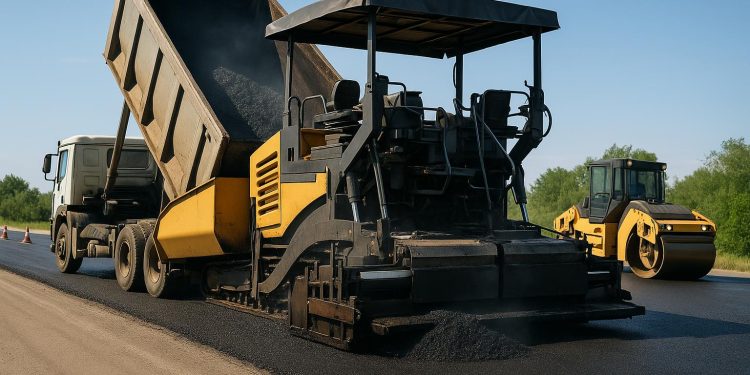While many people starting out in construction and paving operations tend to underestimate the particulars that go into all operations, you must not make that mistake. This guide takes you through everything you will likely be expected to oversee.
1. Reverse-Engineer the Project
So, start each project by defining the desired density, grade tolerances, and acceptable temperature windows. Record mix delivery rhythm or tempo-truck spacing and backup-and practice the haul road so suppliers maintain a string of trucks to ensure the correct operation of asphalt pavers. A constant head of mix in the paver hopper eliminates screed bounce and segregation-that one control alone reduces the number of rollers and rework.
2. Streamline Crew Communication
Define clear roles: screed lead, hopper manager, material transfer vehicle operator, rollers lead. Employ a straightforward radio protocol and map the paving train before breaking ground. Well-rehearsed handoffs between dump truck → paver hopper → auger/conveyor keep mat temperature stable, paver operating at steady speed-massive efficiency gain
3. Get the Mix and Feed Right
Create a mix that mat, sos the job’s required compaction energy and anticipated traffic use. On site, keep the paver hopper full and adjust the conveyor/ auger speed to maintain a constant head of material: no surges or starvation for surface defects. Use a material transfer vehicle, MTV when possible or live-bottom trucks, to remediate worn temperatures and prevent segregation. These are successful means to reduce longitudinal and transverse irregularities.
4. Use compaction smartly
where pavement life is won or lost. Forward-thinking operations now use a combination of breakdown, intermediate, and finish rolling in a carefully planned sequence. If available, adopt so-called Intelligent Compaction, or roller-integrated systems-they give real-time stiffness maps and reduce guesswork, letting you hit density targets with fewer passes. Also match roller type and drum frequency in your soil compactor helps avoid over-or under-compaction.
Pro tip: Position the compactor-vibratory roller-to begin compaction directly behind the paver. Minimize time between placement and rolling to lock in density while the mixture is still hot.
5. Avoid Thermal and Material Segregation
Plan sequencing so that the hottest, freshest mix is placed where the most critical density is required. Maintain truck intervals and use remixing MTVs where grade breaks or intermittent supply would otherwise cause cooler spots. Minimize handwork Avoid excessive stops- reheating and spot repairs multiply costs.
6. Maintenance – the Essentials
Any good operator knows that asphalt laying can become manifestly more expensive if daily checks on screed heaters, augers, conveyor chains, and hydraulic systems is not methodically and routinely carried out. Track KPIs: tons placed per hour, passes to final density, number of reworks, and fuel burn. Small, preventive steps-minded chain tension tightened, bearings greased, heater output checked-save bigger losses in downtime.
7. Lean On data for QA/QC
Temperature and compaction data collection should be collected during paving. Record pass counts, density cores, and roller coverage on simple forms or by using tablets. Compaction maps are stored when IC is available and then cross-checked against cores to limit disputes and iterate process improvements.
8. Recycle Sensibly
On projects that reuse millings or reclaimed asphalt pavement RAP, plan a front-end crushing and screening strategy. Primary crushers jaw crushers are commonly used to break reclaimed mat into workable sizes before screening and remixing back into new mixes, reducing material cost and truck haul.
Select crusher capacity to match the job’s throughput and allow for reinforced pieces and contaminants.
9. Safety- On a Rolling Basis
Investment in operator training to run the paver setup, screed tuning, and operation roller is worth the expense- the alternative being an expensive and preventable accident.
Require toolbox talks at every shift and encourage crews to report recurring problems; run after-action reviews to update your playbook. These small feedback loops will compound over time into big productivity gains
In sum, what you need to keep a strict eye on is the following tasks:
- Check mix temperature and gradation
- Truck schedule and MTV availability confirmation.
- Level hopper and test auger/conveyor response.
- Check screed heat and plate alignment.
- Set roller frequencies and mark the rolling pattern.
- Verify radios and safety zones.
Conclusion
Define a decision matrix for machine selection by site context for your asphalt paving operations using the metrics of material competency, access constraints, production rate, and environmental controls. High-throughput highways means larger primary crushers with automated CSS control and a fleet of vibratory rollers with IC. For urban rehabilitation- a good jaw crusher, compact pavers, and mixed pneumatic/smooth-drum rollers for surface quality. Soft subgrades increase padfoot usage and pre-treatments. For recycled mixes with steel select tolerant crushers and deliver tighter feed control.
It is sequencing discipline-contrasting reduction, classification, placement, staged densification-that supplies the leading order determinant of operational efficiency in heavy roadworks. By quantifying crusher output, stabilizing feed, and matching roller types and compaction patterns to material behavior, teams convert raw rock into durable pavement with the minimum required mechanical intervention.







